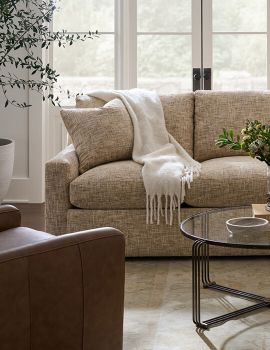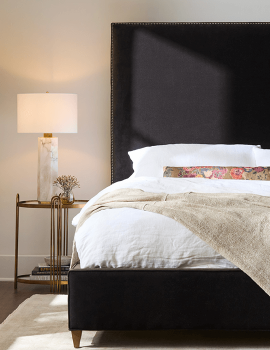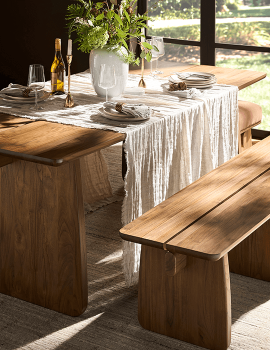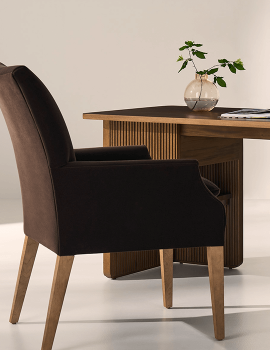Care
Cleaning Codes
Industry Standards - Color Fastness Codes for Spot Cleaning Only
S - Spot Clean
Spot clean with a water-free, dry-cleaning solvent only. Pre-test a small, inconspicuous area first. Do not over-saturate. Do not use water. Cushion covers should not be removed and dry-cleaned as this may cause fabric color to fade. To prevent overall soiling, frequently vacuum or lightly brush with a non-metallic, stiff bristle brush to remove dust and grime. When cleaning a spill, blot immediately to remove spilled material. Clean stains from the outside of the affected area, moving toward the center, to prevent the stain from migrating outward. Pile fabrics may require brushing gently with a non-metallic, stiff bristle brush to restore appearance.
W/S or S/W - Spot Clean or Water Solvent
Spot clean with upholstery shampoo, foam from a mild detergent, or a mild dry-cleaning solvent. Pre-test a small, inconspicuous area for color bleeding, fading, or color transfer. Do not over-saturate. Use a professional upholstery cleaning service for overall soiling.
X - Vacuum Only
Clean only by vacuuming or light brushing with a non-metallic brush. Do not use water or dry-cleaning solvents. Consult a professional upholstery cleaner.
W - Water-Based Shampoo Only
Spot clean only with water-based shampoo or foam upholstery cleaner. Pre-test a small, inconspicuous area for color bleeding, fading, or color transfer. Do not over-saturate. Use professional upholstery cleaning service for overall soiling.
Washable Fabrics
Spot Cleaning
Dilute a mild detergent in distilled water. With a clean white cloth, blot the stained area, working from the outside of the stain inward, to prevent the stain from expanding. Do not rub as this may damage the fabric. Repeat this step to make sure all soap is removed, as any remaining cleaning solutions will attract dirt for future stains and may leave a water mark area that can appear to be a stain.
Machine Washing
MACHINE WASHING - Only SLIPCOVERS in WASHABLE fabrics can be cleaned in a washing machine. Slipcovers have surged and double loop lock stitching on seams to prevent unraveling when washed. Fabrics that are not washable may shrink, fade, or be damaged if washed. Be sure to wash all parts of the slipcover to maintain even color and wear.
Pre-washed fabrics that are not Slipcovers can be spot-cleaned with a water-soluble cleaner but not washed in a washing machine as the seams may unravel.
VACUUM ALL UPHOLSTERY REGULARLY: Use an upholstery brush attachment and apply light pressure. Do not use an electric beater bar attachment or place the vacuum nozzle directly on the fabric as this may damage the fabric.
Fabric Care
- Vacuum the surface of your furniture regularly, including the deck under the cushions, with the upholstery attachments of your vacuum cleaner.
- Direct sunlight can cause the fabrics to fade. Care should be taken to limit the amount of direct sun on any piece of furniture.
- Loose cushions should be flipped and rotated frequently to minimize soiling and add to the longevity of your upholstery.
- All spills should be cleaned immediately, start by blotting the spill using a clean, absorbent cloth. If stain remains, please follow the care instructions below according to the type of fabric on your upholstery.
- To successfully clean fabric, it is important to determine the type of fabric and the recommended cleaning code. The cleaning code for your upholstery can be found on the law tag attached to the furniture. Always pretest an inconspicuous area of the upholstery before spot cleaning.
- If you have purchased an after-market Stain Protection System, please consult the retailer or Stain Protection provider for cleaning instructions.
Caution
Never remove cushion covers for separate dry cleaning or laundering. Do not use bleach, or any tumble method cleaning service as this may destroy the backing of the fabric, shrink, or otherwise damage the upholstery fabric.
Consumer Alert
Keep your furniture and family safe from fires caused by careless smoking. Do not smoke when lying down or drowsy. Always check the furniture where smokers have been sitting for improperly discarded smoking materials. Ashes and lighted cigarettes can fall unnoticed behind or between cushions or under furniture. Do not place or leave ashtrays on the arms of chairs where they can be knocked off. Remove immediately any glowing ember or lighted cigarette that has fallen on furniture. Smoldering smoking materials can cause upholstered furniture fires.
Slipcover Care
Even if you have a washable slipcover you may want to have it professionally dry cleaned. The body slipcover of a sofa is a fairly bulky load, requiring a "laundromat" type of washer. Should you choose to wash your slipcover, follow these instructions.
- We suggest you run the washer through a wash cycle empty before washing your slipcover -- just to be sure it is free of any detergent, bleach, or other impurities that might spot or stain the slipcover.
- We also suggest that you wash the entire slipcover; washing only select parts may result in color variations on the piece of furniture (you may want to consider washing all pieces in the collection at the same time, i.e., wash the sofa, the chair, and the ottoman covers at the same time -- again, to minimize color variations which may occur with washing).
- Don't overload your washer. Separate the slipcover into two loads, washing the body cover in the first load and the cushion covers in the second load.
- Zip the zippers (closed) on the pillow and cushion covers to prevent damage when washing.
- Use the gentle cycle on your washing machine. Use cold water and a mild detergent. Do not use a detergent with bleach or a bleach additive.
- Remove the slipcover from the washer immediately at the end of the cycle. While air-drying is preferred, you can use the dryer - on the NO HEAT setting. Tumble dry until the slipcover is just slightly damp.
- Put the Body slipcover back on the piece of furniture while still slightly damp - you may need to stretch it a little to get it back on. Putting the cover back on while it's still slightly damp ensures it will dry to fit.
- The covers for the seat and back cushions and pillows should be replaced slightly damp as well. Stand the cushions on end, rotating them every 20 to 30 minutes until dry. This will prevent any water that may drain to one side of the cushion from sitting in one place and possibly causing a water stain.
Leather Care
Leather is the longest-lasting and most durable upholstery material you can get, perfect for any room of your home or office. It will withstand the rigors of daily life, including children and pets, and still look great. Although the initial investment in quality leather may be more than fabric upholstery, leather is one of the best values in the long run. With proper care, our quality leather can be expected to last an average person’s lifetime.
- A monthly wiping with a warm and gently damp clean cloth will prevent your body oils and dust from creating a buildup. As easy as it sounds, this maintenance is key to prolonging the life of your leather furniture.
- Do not use saddle soap oils, abrasive cleaners, soaps, furniture polish, varnish, or ammonia-based products. The leather has already been permanently preserved in the tanning process and needs no maintenance other than the simple cleaning recommended.
- In the case of deep cleaning or conditioning, you should use leather-specific cleaners and conditioners. These products are specially designed for this purpose and will not affect the structure of the leather. Recommended 2 to 3 times a year.
Leather Terms
BUFFING - This is a process used to minimize the appearance of surface imperfections such as wrinkles or scars in the finished hide. This process makes the leather more uniform but also brings out the natural grain and markings that make each hide unique and naturally beautiful.
CORRECTED GRAIN - Top-grain leather that has been buffed or sanded to minimize imperfections in the hide.
DRUM DYED - A dying process accomplished by tumbling leather in a rotating drum to encourage the dye to penetrate fully.
EMBOSSING - To mechanically imprint unique grain effects under heat or high pressure to smooth the grain or give a unique patterned look (ostrich, alligator, floral, etc.). Top-grain leather with excessive imperfections is often snuffed (buffed smooth) and then embossed with a grain pattern.
FINISHING - To make leather more durable, clear (aniline) or pigmented substances are applied to the hide. These provide abrasion and stain resistance as well as color enhancement. The finishing process usually involves three to four coating operations. Generally, the more finish a leather has, the stiffer (board-like) it becomes.
FULL GRAIN - Full grain leathers are top grain leathers that have not been corrected in any way, allowing the natural markings and character of the leather to show through. Full grain leathers are, therefore, much richer, cleaner hides to begin with, having minimal scars, etc. which also make them more expensive than corrected grain leathers.
GRAIN - Markings or patterns on the leather surface. Naturally occurring grain is caused by wrinkles, markings, and pores in the hide. Grains can vary even on the same hide depending on location.
HAND - The softness or ‘feel’ of a leather is referred to as its hand.
LEATHER - A collective term used to describe any tanned animal skin.
MILLING - A natural softening process in which leather is tumbled in a dry drum.
NATURAL MARKINGS - These subtle markings on leather are the equivalent of a fingerprint. They distinguish genuine leather from man-made materials. Other marks that can appear on the surface of leather are healed scratches, barbed wire marks, wrinkles, brands, and insect bites. Gross imperfections are normally cut out of the finished product.
PATINA - A luster that naturally occurs as leather ages.
PROTECTED LEATHER - Protected leather is less expensive and more common than pure aniline or semi-aniline leather. Its coloration is more consistent and because it has been coated with protective pigments, the leather’s natural markings are less noticeable. These protected leathers are more heavily pigmented than semi-aniline leather and are easier to clean than pure aniline leather because surface pigments repel water and stains...standing up well to heavy use.
PULL UP - Pull up leather is one that when pulled tight produces a burst of color. Used as an upholstery leather, it gives a worn weathered appearance or a distressed look. Pull ups are full-aniline leathers that have an oil and/or wax application. When the leather is pulled, the oil and/or wax separates causing the color to become lighter.
PURE or FULL ANILINE- is a type of leather in which high-quality hides have been finished with aniline as a dye. This produces a delicate, soft, supple leather.
SAUVAGE - A two-toned effect that adds depth to the leather.
SEMI-ANILINE DYED - The term used to describe aniline-dyed leather which has only a small amount of pigmented finish. It is a premium product that allows the hides natural character to show through.
SPLIT GRAIN - The term refers to the underneath layers of the hide which have been ‘split’ off from the top grain. Splits are buffed, sanded, and embossed to look like top-grain leather. Split hides are stiffer than top-grain leathers. They are used on less expensive furniture and will not be as long-lasting or durable as top-grain leather.
TOP GRAIN - Leather which contains the top portion of the hide...the part that had hair on it. Top grain leather can be full grain or corrected grain leather. The top grain portion of the hide is approximately 3/64’’ about the thickness of a penny.




